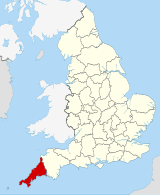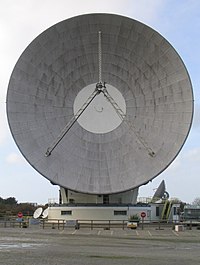Portal:Cornwall
  Cornwall (/ˈkɔːrnwɔːl, -wəl/; Cornish: Kernow; Cornish pronunciation: [ˈkɛrnɔʊ]; or [ˈkɛrnɔ]) is a ceremonial county in South West England. It is recognised by Cornish and Celtic political groups as one of the Celtic nations, and is the homeland of the Cornish people. The county is bordered by the Atlantic Ocean to the north and west, Devon to the east, and the English Channel to the south. The largest settlement is Falmouth, and the county town is the city of Truro. The county is rural, with an area of 1,375 square miles (3,562 km2) and population of 568,210. After Falmouth (23,061), the largest settlements are Penzance, Newquay, St Austell, and Truro. For local government purposes most of Cornwall is a unitary authority area, with the Isles of Scilly having a unique local authority. The Cornish nationalist movement disputes the constitutional status of Cornwall and seeks greater autonomy within the United Kingdom. Cornwall is the westernmost part of the South West Peninsula. Its coastline is characterised by steep cliffs and, to the south, several rias, including those at the mouths of the rivers Fal and Fowey. It includes the southernmost point on Great Britain, Lizard Point, and forms a large part of the Cornwall National Landscape. The national landscape also includes Bodmin Moor, an upland outcrop of the Cornubian batholith granite formation. The county contains many short rivers; the longest is the Tamar, which forms the border with Devon. (Full article...) Selected articleThe Camelford water pollution incident involved the accidental contamination of the drinking water supply to the town of Camelford, Cornwall, in July 1988. Twenty tonnes of aluminium sulphate was inadvertently added to the water supply, raising the concentration to 3,000 times the admissible level. As the aluminium sulphate broke down it produced several tonnes of sulphuric acid which "stripped a cocktail of chemicals from the pipe networks as well as lead and copper piping in people's homes." Many people who came into contact with the contaminated water experienced a range of short-term health effects, and many victims suffered long-term effects whose implications remained unclear . There has been no rigorous examination or monitoring of the health of the victims since the incident, which is Britain's worst mass poisoning event. Inquests on people who died many years later found very high levels of aluminium in the brain. Dame Barbara Clayton led a Royal Commission on Environmental Pollution enquiry into the incident. Immediately after the contamination the authorities said that the water was safe to drink, possibly with juice to cover the unpleasant taste. In an inquest in 2012 into the death of one of the victims, the coroner stated that South West Water Authority had been "gambling with as many as 20,000 lives" when they failed to inform the public about the poisoning for 16 days, a delay he called unacceptable. In the aftermath of the contamination the public were reassured that there was no risk to health. There were allegations of a cover-up and West Somerset Coroner Michael Rose stated: "I found there was a deliberate policy to not advise the public of the true nature until some 16 days after the occurrence of the incident." Following an investigation by the government's Committee on Toxicity of Chemicals in Food, Consumer Products and the Environment, Michael Meacher, the former Environment Minister, claimed that "various associated bodies tried to bury the inquiry from the start." Meacher told one newspaper: "This has become a tug of war between the truth and an attempt to silence the truth." An April 2013 report by the Lowermoor subgroup of the Committee on Toxicity of Chemicals in Food, Consumer Products and the Environment concluded that exposure to the chemicals was unlikely to cause "delayed or persistent harm" and was also unlikely to cause future ill health. In September 2013 the government admitted that there had been a "manifest failure to give prompt appropriate advice and information to affected consumers" and offered an unreserved apology. (Full article...)Selected biographySir Humphry Davy, 1st Baronet, FRS, MRIA, FGS (17 December 1778 – 29 May 1829) was a British chemist and inventor who invented the Davy lamp and a very early form of arc lamp. He is also remembered for isolating, by using electricity, several elements for the first time: potassium and sodium in 1807 and calcium, strontium, barium, magnesium and boron the following year, as well as for discovering the elemental nature of chlorine and iodine. Davy also studied the forces involved in these separations, inventing the new field of electrochemistry. Davy is also credited with discovering clathrate hydrates. In 1799, he experimented with nitrous oxide and was astonished at how it made him laugh. He nicknamed it "laughing gas" and wrote about its potential as an anaesthetic to relieve pain during surgery. Davy was a baronet, President of the Royal Society (PRS), Member of the Royal Irish Academy (MRIA), Fellow of the Geological Society (FGS), and a member of the American Philosophical Society (elected 1810). Berzelius called Davy's 1806 Bakerian Lecture On Some Chemical Agencies of Electricity "one of the best memoirs which has ever enriched the theory of chemistry." (Full article...)
Did you know?
Selected quoteSelected picture
General imagesThe following are images from various Cornwall-related articles on Wikipedia.
WikiProjects
Related portalsTopicsHistory
Geography
Politics
Economy and demographics
Culture
SubcategoriesRecognised content
Featured articlesMain page featured articlesFeatured listsGood articles
Former good articlesIn the News articlesThings you can do'
Associated WikimediaThe following Wikimedia Foundation sister projects provide more on this subject:
Wikipedia in CornishDiscover Wikipedia using portals
| |||||||||||||||||||||||||||||||



































































